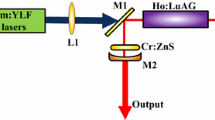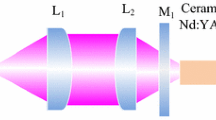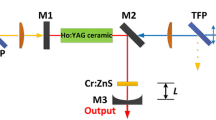Abstract
We report on a passively Q-switched polycrystalline ceramic Er:YAG laser by using a Cr:ZnSe crystal as a saturable absorber. When pumped by a 1532-nm Er-, Yb-doped fiber laser with the maximum power of 12.4 W, the laser yielded pulses of 28.8 ns duration at 1617 nm by using a saturable absorber with an initial transmission of 80 %. The corresponding peak power was up to 11.3 kW at a repetition rate of 2.17 kHz. The dependence of the pulse duration and repetition rate on the pump power was experimentally studied. The numerical and experimental results both show that the pulse duration was mainly determined by the initial transmission of the saturable absorber and slightly affected by the transmission of the output coupler. At last, we give some prospects for further narrowing down the pulse duration.
Similar content being viewed by others
Avoid common mistakes on your manuscript.
1 Introduction
Eye-safe Q-switched Er-doped solid-state lasers operating at around 1.6 μm have lots of applications in remote sensing, ranging and free-space communications and can generate 3- to 5-μm mid-infrared waveband output via nonlinear frequency conversion [1, 2]. For free absorption of the methane in the atmosphere, the 1617-nm transition is more promising for applications which need long-distance propagation in free space than the 1645-nm transition [2, 3].
YAG crystal is used as the most common laser gain host because of its unique thermomechanical properties. Er:YAG crystal lasers have been demonstrated both in continuous-wave and Q-switched modes [1–5]. In 2007, a single-crystal Er:YAG which yielded a continuous-wave (CW) output power of 31 W was demonstrated at 1617 nm with a slope efficiency of 47 % with respect to incident pump power [3]. In 2011, an actively Q-switched 1617-nm single-crystal Er:YAG laser with pulse energy up to 30.5 mJ and pulse duration of <20 ns at 20 Hz repetition rate has been reported [4]. However, the conventional crystals cannot be made in large scale or fabricated composite with a complicated configuration to enhance the laser performance [6]. As a novel laser medium, the polycrystalline ceramics are advantageous over single crystals in many aspects, such as rapid and large volume fabrication, flexibility in doping concentration and profile, and low cost. With the development of the ceramic fabrication technology, the Er:YAG ceramic laser has been reported to have similar laser efficiency and spectroscopic parameters to those of the single crystals [7–9]. In 2010, a composite Er:YAG ceramic laser generated a quasi-CW output power of 6.8 W at 1645 nm and the corresponding slope efficiency of 56.9 % with respect to the absorbed pump power. In the next year, Zhang et al. [10–12] reported a 1617-nm Er:YAG ceramic which yielded an output power of 14 W corresponding to a slope efficiency of 51.7 % with respect to the incident pump power. In the Q-switched mode, the laser performance of the Er:YAG ceramic laser has been reported by using graphene as saturable absorber. However, the graphene Q-switched lasers typically have pulse durations of the order of microseconds. To get short pulse of a few tens of nanoseconds, a better alternative saturable absorber is Cr2+:ZnSe characterized by a large cross section (1.9 × 10−18 cm2), a long relaxation lifetime (8 μs) and absence of the excited-state absorption. The absorption spectrum of the Cr2+:ZnSe is centered at 1780 nm with a bandwidth of 350 nm. It has been used as a passive Q switcher for Er, Tm and Ho lasers [13–15].
In this paper, we report on a passively Q-switched polycrystalline ceramic Er:YAG laser by using Cr2+:ZnSe as the saturable absorber for the first time. The Q-switched laser was in-band pumped by a 1532-nm Er, Yb co-doped laser. The minimum pulse duration of 28.8 ns was obtained by using a saturable absorber with the initial transmission of 80 %, corresponding to pulse energy of 326 μJ and pulse repetition of 2.17 kHz. We proposed and analyzed the further methods to narrow down the pulse duration.
2 Experiments setup
The laser setup of the passively Q-switched Er:YAG ceramic laser is shown in Fig. 1. The pump light is an in-house constructed double-clad Er, Yb fiber laser. The length of the fiber was ~4 m, and the Er, Yb co-doped phosphor–silicate core with a diameter of 30 μm (0.2 NA) was surrounded by a 350-μm-diameter pure silica inner cladding (0.49 NA). By employing a volume Bragg grating with a center wavelength of 1570 nm, the wavelength of the fiber laser was locked at 1532 nm with a line width of 0.2 nm (FWHM) to match the narrow absorption peak of the Er:YAG ceramic [16]. A polycrystalline Er:YAG ceramic of 0.5 at% Er3+-doping concentration (developed at Jiangsu Normal University, China) was cut and polished into a dimension of 5 × 5 × 35 mm3, and both end faces were antireflection-coated at 1500–1700 nm. The Er:YAG ceramic was wrapped with indium foil and mounted in a water-cooled copper heat sink maintained at a temperature of 15 °C. The plane input coupler was coated for high transmission (T > 96 %) at the pump wavelength of 1532 nm and high-reflectivity (R > 99 %) at the lasing wavelength range of 1600–1700 nm. Three output couplers with a radius of curvature of 100 mm were all highly reflective at the pump light, but had a transmission of 10, 20 and 30 % at the lasing wavelength, respectively. The Cr:ZnSe saturable absorber was antireflection-coated at 1500–1700 nm and mounted in a flat aluminum holder for conductive heat removal. It was inserted into the cavity close to the output coupler. The total length of the cavity was 140 mm, resulting in a laser beam radius of 450 μm on the saturable absorber and of 120 μm on the Er:YAG ceramic medium. The temporal behavior of the pulses was recorded by a fast InGaAs PIN photodiode with a rise time of ~10 ns, connected to a Tektronix DPO 7104C digital oscilloscope (25-GHz bandwidth).
3 Results and discussion
The continuous-wave (CW) operation of the Er:YAG ceramic laser was studied first. By using output coupler with a transmission of 10, 20 and 30 %, respectively, the CW laser oscillated at 1645 nm. Then, inserting the Cr:ZnSe saturable absorber into the cavity, the wavelength of the passively Q-switched Er:YAG ceramic laser was shifted to 1617 nm with any one of the three output couplers. We attributed the wavelength shift to the following two reasons. One reason is that the gain cross section of the 1617-nm transition is larger than that of the 1645-nm transition. The Er:YAG ceramic laser tends to operate at 1617 nm at the higher population inversion density in the Q-switched mode. The other reason is that the absorption coefficient of the Cr:ZnSe is higher at 1645 nm than 1617 nm. The relationship between the output power of the Er:YAG ceramic laser and the pump power in CW- and Q-switched modes with output coupler of 30 % transmission are shown in Fig. 2. At the maximum available pump power of 12.4 W, the Er:YAG ceramic laser in the CW mode yielded an output power of 4.1 W, and the corresponding slope efficiency with respective to the incident pump power was 36.6 %. By using the saturable absorber with an initial transmission of 90 and 80 %, the passively Q-switched laser yielded an average output power of 955 and 708 mW, respectively.
The pulse width and repetition rate as functions of the incident pump power are given in Figs. 3 and 4. From the two figures, one can see that the pulse duration and repetition rate were mainly determined by the initial transmission of the saturable absorber and slightly affected by the transmission of the output coupler. This can be explained by the theoretical analysis of the rate equations of the passively Q-switched laser. For an accurate theoretical study, the intracavity photon density and the initial population inversion density of the gain medium and the saturable absorber are assumed to be Gaussian spatial distributions. The excited-state absorption of the saturable absorber Cr:ZnSe can be negligible, and the energy-transfer upconversion of the gain medium is ignored. By modifying the rate equations in Ref. [17], we obtained
where n(r,t) and n a(r,t) are, respectively, the population inversion densities of the gain medium and the saturable absorber; σ and σ a are, respectively, the stimulated-emission cross section of the gain medium and the absorption cross section of the saturable absorber; l and l a are, respectively, the lengths of the gain medium and the saturable absorber; R is the reflectivity of the output coupler. L is the remaining round-trip dissipative optical loss; γ and γ a are, respectively, the inversion reduction factors of the gain medium and the saturable absorber; S and S a are, respectively, the beam cross section areas in the gain medium and in the saturable absorber; c is the light speed in vacuum; t r is the round-trip transit time of light in the laser resonator.
We define a parameter α,
The larger the α is, the more easily the saturable absorber is bleached before the gain medium is bleached and the more easily the Q-switched pulse laser is generated [14]. The parameters used in the modeling are given in Table 1. To make the simulated pulse duration close to the real one, the initial photon density should be set at a small value (for example, ~10−5 of the peak photon density). The initial population inversion densities of the gain medium and the saturable absorber were set to zero. By solving the rate equations, we obtained the pulse durations with different reflectivities R of the output coupler and different initial transmissions T 0 of the saturable absorber. Figure 5 shows the pulse duration as a function of the initial transmission of the saturable absorber for different values of α, when the reflectivity of the output coupler is 70 %. Figure 6 shows the relationship between the pulse duration and the reflectivity of the output coupler for different values of α, when the initial transmission of the saturable absorber is 80 %. The ratio of the absorption cross section of the saturable absorber to the stimulated-emission cross section of the Er:YAG ceramic is about 400. In order to avoid the damage to the antireflection film on the saturable absorber, the laser beam area on the saturable absorber should not be too small. As a result, the parameter α is about 14 in the experiment. Thus, the pulse duration as a function of the initial transmission of the saturable absorber and the reflectivity of the output coupler can be referred by the curve lines (c) in Figs. 5 and 6. The numerical results in Figs. 5 and 6 show that the pulse duration and the pulse repetition rate mainly depend on the initial transmission of the saturable absorber. The value of the calculated pulse duration is smaller than the measured one due to the absence of the energy-transfer upconversion. However, it has a similar trend to the experimental one. Thus, in order to narrow down the pulse duration, we should use saturable absorbers with smaller initial transmission and reduce the length of laser cavity. It means that the laser beam area on the saturable absorber will be reduced too. Therefore, in the next step, we should improve the antireflection film on the saturable absorber or use an uncoated saturable absorber at Brewster angle.
The pulse repetition rate increases with pump power, while the pulse duration decreases with the pump power. At high pump power, however, the pulse width remained approximately constant and the pulse repetition began to fall down. We attributed the falling down of the pulse repetition to that the pulse train was subdivided into a pulse train containing pulses of two or more amplitudes that replicated themselves periodically. The time interval between the pulses depended on the amplitudes. The minimum pulse width of 28.8 ns was obtained by using a saturable absorber with initial transmission of 80 % and an output coupler with transmission of 30 % at highest pump power of 12.4 W. The typical temporal behaviors of the output pulse with a repetition rate of 2.2 kHz are shown in Fig. 7 in a timescale of 5 ms. The variations of the pulse-to-pulse amplitude were within 2.5 %.
4 Conclusion
In summary, we demonstrate a passively Q-switched Er:YAG ceramic laser using Cr:ZnSe as the saturable absorber. With a saturable absorber of 80 % initial transmission and an output coupler of 70 % transmission, stable Q-switched laser pulses of 28.8 ns (FWHM) in duration, 11.3 kW in peak power and 326 μJ in energy were obtained at a pump power of 12.4 W. The pulse duration should be able to be further narrowed down and peak power be further improved by reducing the initial transmission of the saturable absorber or increasing the ratio of the laser beam size on the gain medium to that on the saturable absorber. An antireflection-coated saturable absorber or an uncoated one used at Brewster angle should also be able to improve the laser performance.
References
S.D. Setzler, M.P. Francis, Y.E. Young, J.R. Konves, E.P. Chicklis, IEEE J. Sel. Top. Quantum Electron. 11, 645–657 (2005)
M. Wang, L. Zhu, W. Chen, D. Fan, Opt. Lett. 37, 2682–2684 (2012)
J.W. Kim, D.Y. Shen, J.K. Sahu, W.A. Clarkson, Opt. Expr 16, 5807–5812 (2009)
J.W. Kim, J.K. Sahu, W.A. Clarkson, Appl. Phys. B 105, 263–267 (2011)
M. Wang, L. Zhu, W. Chen, D. Fan, Opt. Lett. 37, 3732–3734 (2012)
T. Kamimura, T. Okamoto, Y.L. Aung, A. Ikesue, In Conference on Lasers and Electro-Optics/Quantum Electronics and Laser Science Conference and Photonic Applications Systems Technologies, OSA Technical Digest Series (CD) (Optical Society of America, 2007), paper CThT6
C. Zhang, D.Y. Shen, Y. Wang, L.J. Qian, J. Zhang, X.P. Qin, D.Y. Tang, X.F. Yang, T. Zhao, Opt. Lett. 36, 4767–4769 (2012)
D.Y. Shen, H. Chen, X.P. Qin, J. Zhang, D.Y. Tang, X.F. Yang, T. Zhao, Appl. Phys. Exp. 4, 05270 (2011)
N. Ter-Gabrielyan, L.D. Merkle, E.R. Kupp, G.L. Messing, M. Dubinskii, Opt. Lett. 35, 922–924 (2010)
X.Q. Zhang, J. Liu, D.Y. Shen, X.F. Yang, D.Y. Tang, D.Y. Fan, I.E.E.E. Photon, Technol. Lett. 25, 1294–1296 (2013)
Z.X. Zhu, Y. Wang, H. Chen, H.T. Huang, D.Y. Shen, J. Zhang, D.Y. Tang, Laser Phys. Lett. 10, 055801 (2013)
Q.L. Bao, H. Zhang, Y. Wang, Z.H. Hua, Y.L. Yan, Z.X. Shen, K.P. Loh, D.Y. Tang, Adv. Func. Mater. 19, 3077–3083 (2009)
T.Y. Tsai, M. Birnbaum, Appl. Opt. 40, 6633–6637 (2001)
A. Aubourg, J. Didierjean, N. Aubry, F. Balembois, P. Georges, Opt. Lett. 38, 938–940 (2013)
Y. Terekhov, I.S. Moskalev, D.V. Martyshkin, V.V. Fedorov, S.B. Mirov, Proc. SPIE 7578, 7578J (2010)
J.W. Kim, D.Y. Shen, J.K. Sahu, W.A. Clarkson, IEEE J. Sel. Top. Quantum Electron. 15, 361–371 (2009)
X.Y. Zhang, S.Z. Zhao, Q.P. Wang, J. Opt. Soc. Am. B 17, 1166–1175 (2000)
Acknowledgments
This work is supported by the National Natural Science Foundation of China (NSFC 61078035, 61177045), the Research Fund for the Doctoral Program of Higher Education of China (RFDP: 20110071110016) and the Priority Academic Program Development of Jiangsu Higher Education Institutions (PAPD).
Author information
Authors and Affiliations
Corresponding author
Rights and permissions
About this article
Cite this article
Zhang, X., Shen, D., Huang, H. et al. Passively Q-switched 1617-nm polycrystalline ceramic Er:YAG laser using a Cr:ZnSe saturable absorber. Appl. Phys. B 120, 305–309 (2015). https://doi.org/10.1007/s00340-015-6137-6
Received:
Accepted:
Published:
Issue Date:
DOI: https://doi.org/10.1007/s00340-015-6137-6











